It's one thing to have a dusty workbench but you'll want to have a shop air filtration system to keep the dust out of the air which can cause long term health problems.
It is recommended that you have an air filtration system in your workshop to work in conjunction with a dust collection system. Your dust collection system will collect the larger particles whereas the air filtration system will capture the smaller particles that float around in the shop and generally end up deep into your lung cavities.
There are many complete air filtration systems you can buy for your shop or garage from places like your local big box store to specialty workshop equipment suppliers.
The cost for an off the shelf system are around $200 into the $1000+ depending on the size, how much CFM (Cubic Feet per Minute) being displaced, and type of filters to use.
You're probably thinking that a few hundred dollars for a literal life-saving device is well worth the price..right?
It surely is...but, yes there is a but, even for this. Like many filtration systems for shops or homes, whether it be for air or water. I feel the real profit for companies that build them is not in the machine itself but in the sale of the replacement filters.
Many of the off-the-shelf filter systems require specialty filters that can run from approximately $35 to $100+ to replace. Depending how much work you do in the shop it may end up having to replace those filters once a month or more.
Here's where a DIY air filtration system will not only save you on t he cost of the system itself but you can use a variety of filters used for your home furnace that you can buy in bulk considerably cheaper than the specialty shop filtration filters.
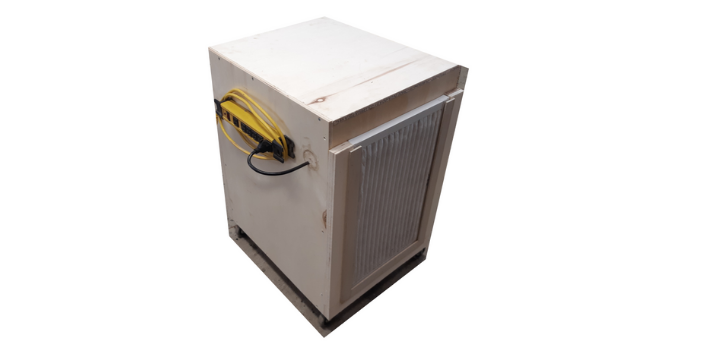
We built our own filtration system using some leftover plywood we had and built on wheels that can also be used as a sanding station.
I've seen other examples online and on Youtube where most people will use a box fan and slap a furnace filter to it.
Although these quick and cheap air filter systems do remove dust from the air We didn't feel they would be very efficient.
That's where our design came into play. We wanted something on wheels and have an added purpose our shop.
We saw an example of this idea on a Youtube Channel from Jennie and Davis. They created their air filter using an old furnace fan.
We weren't too keen on the idea of re-wiring an old furnace fan so we ended up buying a similar type of fan but it has it's own extension cable, extra receptacles, and a switch.
Now all we had to do is build a box with slots to slide 2 furnace filters and this is the final product.

The Blower
We started by buying the blower /air mover so we can figure the size of wood cabinet we would need to build.
We came across this blower form Lowe's that was on sale and it had many features that other blowers didn't have at the same price point.
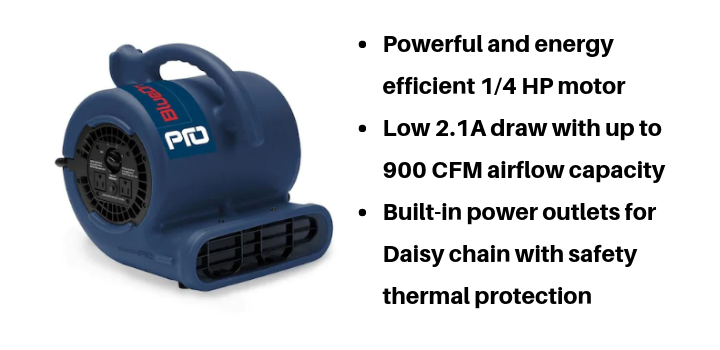
The cost of the blower was under $100 and having it all wired and ready to go was the safest way to go.
With the blower in hand we were able to start planning and building the cabinet in which it would be housed.
We had some left-over plywood from another home renovation project and we started measuring and planning.
We knew the size of the opening for the blower output and that we would probably want to use the most common furnace air filter size being 16" x 25" x 1".
You can buy furnace filters that size from approximately $2 each to $20+ if you want the Hepa level of filtration.
We planned to purchase a mid-range filter that will ensure that the smaller dust particles are caught but we don't necessarily need to catch particles the size of bacteria or viruses.
A mid-range filter will cost around $10 individual but can get them cheaper if bought in bulk.
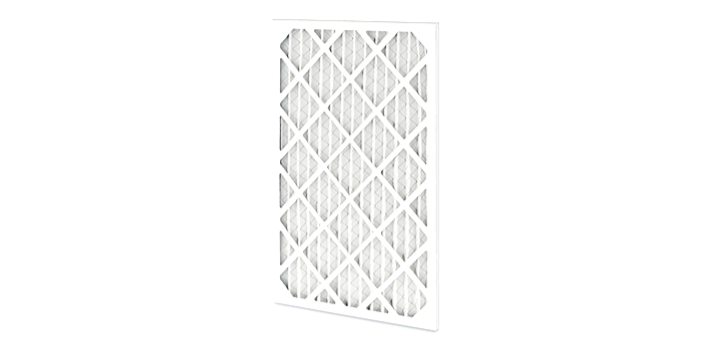
With some rough sketches and ideas on paper we started with designing in SketchUp.
How We Built It
Design and Dimensions
*Please be aware that these dimensions worked for the air blower we purchased. Size and openings may need to be adapted for your air blower.

Preparation
Shopping List
- 48" x 96" Plywood -Type of plywood is your choice but I suggest 3/4" for strength and decreased noise.
- Air Blower
- Furnace Filter
- Power bar or power switch
Materials
- 3/4" sheet of plywood
- Pocket Hole Screws
- Wood Screws
- Wood Glue
- Brad Nails
- Paint or stain of your choice
Tools
Must Have Tools
- Safety Glasses
- Ear Protection
- Dust Mask
- Sandpaper
- Drill
- Tape Measure
- Square
- Circular Saw
- Paint Brush
Advanced Tools
- Compound/Miter Saw
- Table Saw
- Pocket Hole Jig
- Impact Drill
- Orbital Sander
- HVLP Paint Sprayer
Steps To Building The Shop Air Filtration System
Once you have all your materials and tools in place this is easily a one day project.
You start by cutting your sheet of plywood according to the cut list above.
Then it is as easy as constructing a wooden box / cabinet.

We feel really bad that we don't have any images or video while we built this air filter system. It's one of those newbie errors where Paul inadvertently deleted files before uploading them.
We hope that these images, along with the SketchUp plan and cut list is sufficient to get you through building this project.
It really comes down to knowing how to build a cabinet or wooden box. Taking the two solid side pieces, the top piece and the bottom piece. Connecting them together to make a box. Either by using pocket hole screws. Or using a combination of glue, wood screws.
The open sides where the filters go you can make the frame using pocket holes or you can rely on the filter holder track pieces to connect the pieces together. Either way will work.
We will have better pictures on our next project.
The image below shows the side with the power bar that we added.
As this will be a dual purpose unit with the shop air filter and can be used as a workstation for either a power tool . We're planning on getting an oscillating spindle sander at some point and feel this would be the perfect size of cabinet to attach it.
Having that power bar works for two reasons.
- We don't have to remove the filter each time to turn on the blower fan as the switches are on the fan itself in the cabinet. The power bar has its own switch.
- We can plug in whatever tool we plan to attach to the top or plug any hand tool and use the cabinet top as a workstation while the filter sucks in the dust.
Power Bar side.
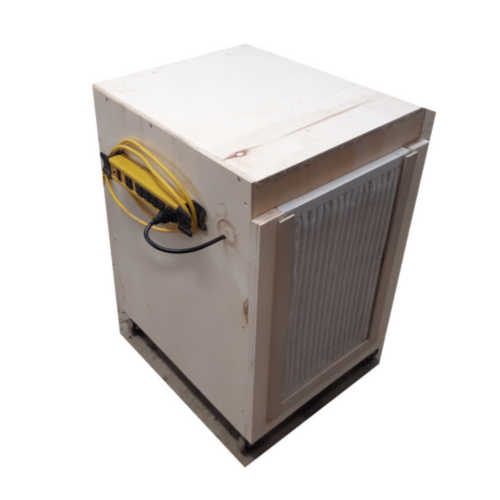
We passed the air blower power cord through the side wall by first drilling a small hole the size of the cord diameter, then drilled a larger hole using a hole drill large enough to pass the plug head through.
Keeping the hole plug from drilling the big hole we first put the cord through the large hole, then put the drill hole plug piece back in place allowing the smaller drilled hole to let the cable pass through. Then we sealed the whole drill hole area with clear silicon.
Air blower output side.
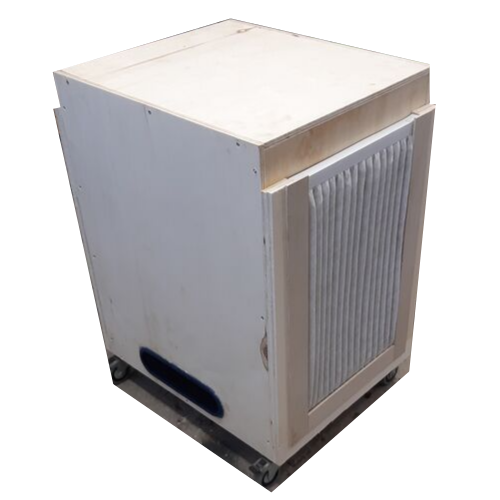
Figuring out the size and shape for the air blower hole on the output side we basically put it up against the plywood and traced it out.
We cut the opening using a jigsaw and sanded to fit snug, then sealed it with silicon as well.
Final Touch
Being that this unit will be on the floor level, we decided to add casters so we can move it about the shop and closer to areas that we are working, in hopes to catch as much dust as quickly as possible.
We left ours natural wood color but you can certainly stain it or paint it with your custom colors.
Conclusion
This shop air filtration system works great! It was also cheap and easy to build. As mentioned earlier we've seen people use various types of old fans to create their air filter system but we like having a air blower that has it's own 3 speed controller and breaker for safety reasons.
Let us know if you've built an air filter similar to this one or if you built one based on our plan, send some pics we would love to see them.

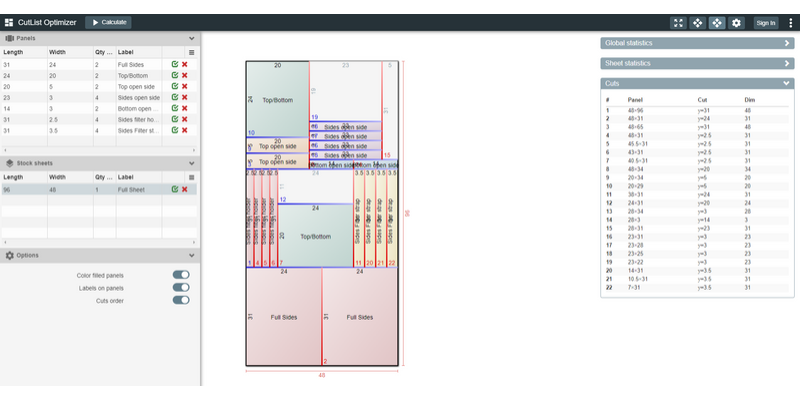
Wow! How long did it take you to build this? It looks great and the steps seem easy to follow. These homemade air filtration systems probably last a long time, right? You definitely save money on filters.
I would love to try this out, but I think I am going to need someone to help me do this. I am not that experienced in cutting wood. What was the total cost of the materials? I understand that it was below $100US?
I am definitely looking forward to any other DIY products you are going to share here on your website. I’m interested in learning more and getting more ideas.
It didn’t take long to build using a table saw and some hand tools, about 2-3 hours. The cost of the air blower was on sale for under $100 and the cost of a sheet of plywood is about $40. We didn’t have to buy any plywood as we had some pieces leftover from other projects.
The savings on filters is well worth it. Instead of $35+ each we can buy a bundle of 3 air filters for about $12.
Cheers
Paul
Hi Paul /
Could you send me high resolution cutlist image? I downloaded but can’t see clearly any dimensions.
My email:
hiddenThanks so much /
Thank you for bringing this to my attention. I will certainly send you an updated link to a high-resolution cut list. We now have a link to a PDF format available below the image. We really appreciate your feedback.
Cheers
Paul
I think other website proprietors should take this web site as a model, very clean and great user friendly style and design, let alone the content. You’re an expert in this topic!
Thank you. I hope you find our other blogs and videos as helpful.
Cheers
Paul
That’s a good idea to have both an air filter and an option for a dust collections system. I like woodworking, but I have asthma, so having a lot of sawdust and things like it, make it hard to breathe. Hopefully, an air filter and dust collector would be able to do the trick to keep the air in the shop clean.
Our original idea is to have both the air filtration system and the dust collection system on the top. So far we only have the air filtration system and currently attached the combination disk and belt sander on the top. Eventually, we will switch out the sander with a dust collector once get around to building a dust collector using our current shop vacuum.
Cheers
Paul
It makes sense that the real revenue for these companies comes from the sale of the filters over time. My brother is trying to get a new filtration system in his workshop this month. He wants to make sure he isn’t breathing in a lot of dust throughout the day so his lungs are healthy.
We were never too concerned about the dust in our workshop when we were doing odd projects but now that we are in there practically every day we want to make sure we keep our lungs clear of all the dust and fumes if possible. The air filtration system we built works quite well. We also bought a better dust collection system that has a1 micron filter on it as well. You can see my Youtube video here where we compare the new dust collector to our shop vacs => https://youtu.be/NhlVdV1nO00 We hope you found this article helpful and thank you for visiting and commenting. Cheers Paul
The best diy I’ve seen so far. I have a 28′ × 28′ × 10′ garage/shop and some modification to this should work fine. A good base for me to start.
Thanks, Lamarre
Thanks. I may be converting it to be used in a paint sprayer booth. An updated blog and video to follow.
I agree that paying a bit of money for cleaner air is totally worth it. My cousin wants a new air filter. She needs to find a machine that will do this setup for her.
It’s nice to build your own that can move more air and use standard furnace filters vs having to buy more specialty filters for the more expensive shop air filtration systems.
This post on shop air filtration systems is really informative! it’s great to learn about the importance of clean air for both safety and comfort in the workplace. the tips on choosing the right system are super helpful. thanks for sharing such valuable insights!